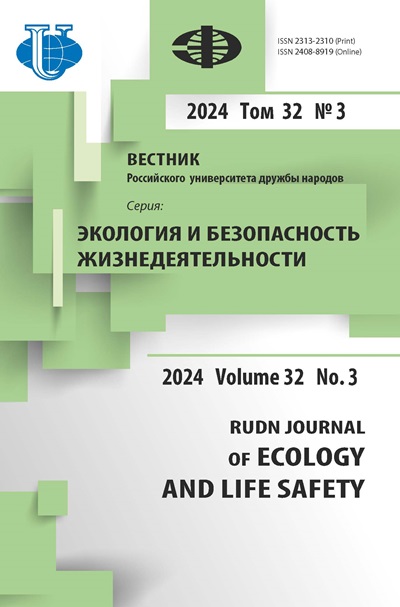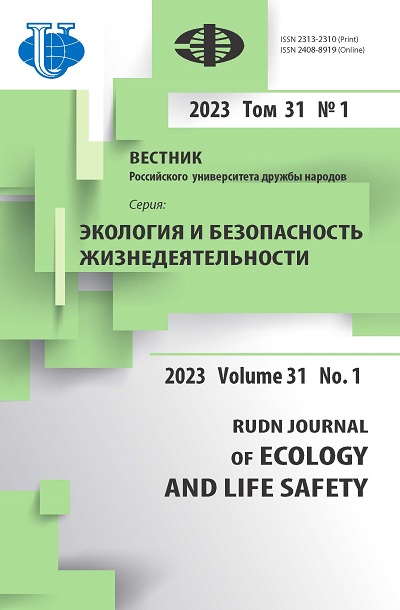Features of the relationship between elemental composition and immune reactions in representatives of ethno-demographic groups of the North-East of Russia
- Authors: Gorbachev A.L.1, Kirichuk A.A.2, Pokhilyuk N.V.3
-
Affiliations:
- Northeastern State University
- Peoples’ Friendship University of Russia (RUDN University)
- State Budgetary Healthcare Institution «Magadan Regional Hospital»
- Issue: Vol 31, No 1 (2023)
- Pages: 55-69
- Section: Human ecology
- URL: https://journals.rudn.ru/ecology/article/view/34266
- DOI: https://doi.org/10.22363/2313-2310-2023-31-1-55-69
- EDN: https://elibrary.ru/KKZVFB
Cite item
Full Text
Abstract
The content of some chemical elements that support immune responses (selenium, zinc, iron, iodine) was analyzed among representatives of the ethno-demographic groups of the North-East of Russia - natives (Chukchi, Koryaks, Evens), mestizos, and newcomers. A potential risk group for the development of hyposelenoses is the Koryak ethnic group. The minimum values of zinc were found among the Chukchi. In representatives of all ethno-demographic groups, the iron content was within the reference values, but its maximum values were noted in the newcomers. The maximum iodine levels are also characteristic of the newcomers. Comparable iodine content was noted in the Evens group. Features of the elemental status (selenium, zinc, iron, iodine) in the inhabitants of the north indicate that among the ethno-demographic groups, it is the aboriginal ethnic groups that are most predisposed to the development of immunodeficiency states.
Keywords
About the authors
Anatoly L. Gorbachev
Northeastern State University
Email: gor000@mail.ru
ORCID iD: 0000-0002-2432-3408
SPIN-code: 7050-3412
Doct. Sci (Biol.), Professor of the Department of Valeology
13 Portovaya St, Magadan, 685000, Russian FederationAnatoly A. Kirichuk
Peoples’ Friendship University of Russia (RUDN University)
Author for correspondence.
Email: kirichuk-aa@rudn.ru
ORCID iD: 0000-0001-5125-5116
SPIN-code: 9483-2011
Doctor of Biology, Director of the Department of Human Ecology and Bioelementology of the Institute of Ecology
6 Miklukho-Maklaya St, Moscow, 117198, Russian FederationNatalya V. Pokhilyuk
State Budgetary Healthcare Institution «Magadan Regional Hospital»
Email: natalis2686@mail.ru
SPIN-code: 5253-5527
Bacteriologist Doctor 40 Nagaevskaya St, Magadan, 685000, Russian Federation
References
- Avtsyn AP. Deficiency of essential microelements and its manifestation in pathology. Pathology Archive. 1990;3:3–8. (In Russ.)
- Agadzhanyan NA, Marachev AG, Bobkov GA. Ecological human physiology. Moscow, Kruk Publ.; 1998. (In Russ.)
- Alekseeva IA, Khotimchenko SA, Stepchuk MA, Sukhanov BP. To the question of the state of mineral metabolism in the indigenous and alien population living in the regions of the Far North. Occupational Medicine and Industrial Ecology. 1996;6:43–46. (In Russ.)
- Aukhatova SN. Influence of iodine on metabolic processes in the body. Successes of modern natural science. 2006;1:32–33. (In Russ.)
- Beketova GV, Goryacheva IP. Zinc and its impact on human health during the COVID-19 pandemic: what's new? Pediatrics. Eastern Europe. 2021;9(1):8–20. (In Russ.)
- Brachun TA, Sakhibgoryaev VH. Chukchi ethnos: genesis and crisis. Magadan: Noosphere Publ.; 2009. (In Russ.)
- Golubkina NA, Papazyan TT. Selenium in nutrition: plants, animals, humans. Moscow, 2006. (In Russ.)
- Golubkina NA, Sindireva AV, Zaitsev VF. Interregional variability of the human selenium status. South of Russia: ecology, development. 2017;12(1):107–127 (In Russ.)
- Goltsova TV, Osipova LP. Genetic and demographic structure of the populations of the indigenous peoples of Siberia in connection with the problems of microevolution. Bulletin of the Vavilov Society of Geneticists and Breeders. 2006;10(1):126–154. (In Russ.)
- Gorbachev AL. Some results and tasks of northern bioelementology. Bulletin of the North-Eastern Scientific Center of the Far Eastern Branch of the Russian Academy of Sciences. 2019;3:117–123. (In Russ.)
- Gorbachev AL. Some environmental and medical problems of the North. Bulletin of the North-Eastern Scientific Center of the Far Eastern Branch of the Russian Academy of Sciences. 2020;4:105–113. (In Russ.)
- Gorbachev AL, Bulban AP. Provision of selenium to residents of the Magadan region. Possible ways to prevent selenium deficiency. Bulletin of the North-Eastern State University. 2010;14:78–82. (In Russ.)
- Gorbachev AL, Lugovaya EA. Elemental profile of the organism of aboriginal inhabitants of the North-East of Russia. Bulletin of the North-Eastern State University. 2015;1:86–94. (In Russ.)
- Gorbachev AL, Skalny AV. The content of iodine in hair as an indicator of iodine status at the individual and population levels. Trace elements in medicine. 2015;16(4):41–44. (In Russ.)
- Gorbachev AL, Skalny AV, Lugovaya EA. Some patterns of the elemental status of the inhabitants of the northern regions of Russia against the background of the biogeochemical characteristics of the North. Bulletin of restorative medicine. 2008;5A(28):22–25. (In Russ.)
- Dudarev AA. Persistent polychlorinated hydrocarbons and heavy metals in arctic biosphere: the main regularities of exposure and reproductive health of indigenous people. Biosphere. 2009;1(2):186–202 (In Russ.)
- Kozlov AI, Kozlova MA, Vershubskaya GG, Shilov AB. Health of the indigenous population of the North of the Russian Federation: on the verge of centuries and culture. Perm; 2012. (In Russ.)
- Kirichuk AA. The relationship of the exchange of essential trace elements and the functional state of the cardiovascular system in international students. Trace Elements in Medicine. 2020;21(3):33−42 (In Russ.)
- Kovalsky JG, Golubkina NA, Papazyan TT, Senkevich OA. The human selenium status of Khabarovsk land in 2018. Trace Elements in Medicine. 2019; 20(3):45−53 (In Russ.)
- Kudrin AV, Skalny AV, Zhavoronkov AA, Skalnaya MG. Immunopharmacology of trace elements. KMK Publ.; 2000. (In Russ.)
- Lytkina KA. Iron deficiency and immunity: what’s new in the third decade of the 21st century? Unique possibilities of ferroceron. Attending Doctor. 2022;5–6(25):70–76. http://doi.org/10.51793/OS.2022.25.6.013 (In Russ.)
- Lyalikov SA, Sobieska M, Gavrilik LL. Iodine as a factor modifying immunity. Ecological Immunology. 2004;2:63–67. (In Russ.)
- Maksimov AL. Modern methodological aspects of the adaptation of aboriginal and indigenous populations in the North-East of Russia. Human Ecology. 2009;6:17–21.
- Maksimov AL, Gorbachev AL. Physiological and morphological features of the formation of thyroid status in the aboriginal and visiting population of the Magadan Region. Human Physiology. 2001;27(4):130–136. (In Russ.)
- Manchuk VT. Features of the formation of health among the population of the North and the main directions of its rehabilitation. Kamchatka – a health resort of the north-eastern regions of Russia: materials and reports of the second interregional. scientific and practical. Conf., Petropavlovsk-Kamchatsky, October 22–24, 2009. Petropavlovsk-Kamchatsky: Research Geotechnological Center of the Far East Branch of the Russian Academy of Sciences Publ.; 2009. р. 137–144. (In Russ.)
- Manchuk VT, Nadtochy LA. Status and trends in the formation of the health of the indigenous population of the North and Siberia. Bulletin of the Siberian Branch of the Russian Academy of Sciences. 2010;30(3):24−32. (In Russ.)
- Pavlenko VI, Kutsenko SYu. Providing a Comfortable Life Activity in the Arctic: Problems and Challenges. Human Ecology. 2018;2:51–58. (In Russ.)
- Pavlenko VI, Petrov A, Kutsenko SYu, Detter GF. Indigenous Peoples of the Russian Arctic (Problems and Development Prospects). Human Ecology. 2019;1:26–33. (In Russ.)
- Petrov IM, Gagina TA, Troshina IA, Medvedeva IV. Modern features of nutrition and the immune system. Siberian Medical Journal. 2006;6:10–14. (In Russ.)
- Pokhilyuk NV, Gorbachev AL. Interethnic features of elemental status of indigenous small-numbered peoples of the North. Trace Elements in Medicine. 2016;17(1):19−23 (In Russ.)
- Saitov ShO, Musaeva DM. Biological role of macro- and micronutrients at COVID-19. Tibbetda yangi kun. 2021;2(34):424–428. (In Russ.)
- Salnikova EV. Zinc – essential trace elements (review). Bulletin of the Orenburg State University. 2012;10(146):170–172. (In Russ.)
- Troegubova NA, Rylova NV, Samoylov AS. Micronutrients in the diet of athletes. Gastroenterology. 2014;1(77):46–49. (In Russ.)
- Troshina ЕА, Senyushkina ЕS, Terekhova МА. The role of selenium in the pathogenesis of thyroid disease. Clinical and experimental thyroidology. 2018;14(4):192–205. (In Russ.)
- Oberlis D, Harland B, Skalny A. Biological role of macro- and microelements. St. Petersburg: Nauka Publ.; 2008. 544 р. (In Russ.)
- Khasnulin VI. A modern view of the health of the indigenous people of the North. Sever-Person: Problems of Health Preservation: Materials of the All-Russian Scientific Conference with International Participation, dedicated to the 25th anniversary of the Research Institute of Medical Problems of the North, Siberian Branch of the Russian Academy of Sciences. Krasnoyarsk, 2001:27–33. (In Russ.)
- Khakhovskaya LN. Indigenous peoples of the Magadan region in the XX-beginning of the XXI century. Magadan: North-Eastern Scientific Center of the Far Eastern Branch of the Russian Academy of Sciences Publ.; 2008. (In Russ.)
- Augustine LF, Mullapudi V, Subramanian S. Infection-iron interaction during COVID-19 pandemic: Time to redesign iron supplementation programs. Kulkarni B. Med Hypotheses. 2020;143:110173. http://doi.org/10.1016/j. mehy.2020.110173 Epub 2020 Aug 10.
- Gorbachev AL, Lugovaya EA, Skalny AV. Bioelement status shown by the aboriginal residents of Russia’s northern regions. Conservation of environment for human health. National environmental Science Academe. NewDelhi; 2013. р. 65–73.
- Combs GF. Biomarker of selenium status. Nutrients. 2015;7:2209–2236. http://doi.org/10.3390/nu7042209
- Skalny AV. Reference values of the concentration of chemical elements in hair obtained by the ISP-NPP method (ANO Center for Biotic Medicine). Trace elements in medicine. 2003;4(1):65. (In Russ.)
















